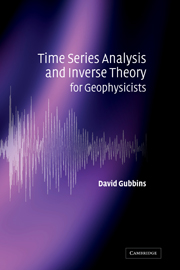Book contents
- Frontmatter
- Contents
- Preface
- Acknowledgements
- List of illustrations
- 1 Introduction
- Part I Processing
- Part II Inversion
- Part III Applications
- 10 Fourier analysis as an inverse problem
- 11 Seismic travel times and tomography
- 12 Geomagnetism
- Appendix 1 Fourier series
- Appendix 2 The Fourier integral transform
- Appendix 3 Shannon's sampling theorem
- Appendix 4 Linear algebra
- Appendix 5 Vector spaces and the function space
- Appendix 6 Lagrange multipliers and penalty parameters
- Appendix 7 Files for the computer exercises
- References
- Index
12 - Geomagnetism
Published online by Cambridge University Press: 05 June 2012
- Frontmatter
- Contents
- Preface
- Acknowledgements
- List of illustrations
- 1 Introduction
- Part I Processing
- Part II Inversion
- Part III Applications
- 10 Fourier analysis as an inverse problem
- 11 Seismic travel times and tomography
- 12 Geomagnetism
- Appendix 1 Fourier series
- Appendix 2 The Fourier integral transform
- Appendix 3 Shannon's sampling theorem
- Appendix 4 Linear algebra
- Appendix 5 Vector spaces and the function space
- Appendix 6 Lagrange multipliers and penalty parameters
- Appendix 7 Files for the computer exercises
- References
- Index
Summary
Introduction
Global mapping of the Earth's main magnetic field is a very old scientific problem, dating from the earliest times of navigation in the days of European exploration. Measurements of the magnetic field are used to construct a global map of all three of its components. Initially measurements of one component, the declination or angle between the compass direction and true North, were hand-contoured on a map. The modern era dates from C. F. Gauss, who developed the theory for representing the magnetic field in terms of spherical harmonics (Section 12.2), least-squares analysis, and an early network of magnetic observatories. Since the 1960s a reference magnetic field, the International Geomagnetic Reference Field (IGRF), has been published every five years and, by international agreement, is used as the standard for mapping purposes. The IGRF is now built into GPS instruments to convert between true and magnetic bearings, and is used to define the compass direction on maps and marine charts. Updating is needed every five years because the Earth's magnetic field changes by a per cent or two during that time. The IGRF poses a classic parameter estimation problem: we need a concise, accurate model of the magnetic field using a simple representation with as few parameters as possible. It is not well suited to scientific study of the magnetic field because of the nature of international agreement: the criteria vary from epoch to epoch depending on the available data and even on political considerations from the contributing countries.
- Type
- Chapter
- Information
- Time Series Analysis and Inverse Theory for Geophysicists , pp. 188 - 212Publisher: Cambridge University PressPrint publication year: 2004
- 1
- Cited by



